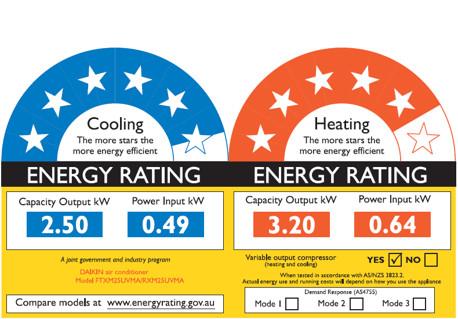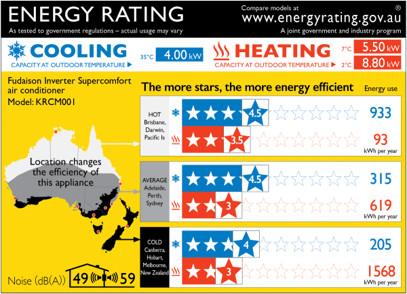In one of our previous blogs, we’ve shared the importance of checking the energy rating label of air conditioners. We’ve also explained how it helps in choosing the most economical cooling unit in the market.
But, did you know that there’s a new energy rating label and it’s granted to Daikin’s Split system air conditioners?
Yes, and it’s called Zoned Energy Rating Label (ZERL).
So, for this blog, we’ll help you understand what is ZERL given to the split system air conditioners of Daikin.

The new Zoned Energy Rating Label
Getting efficient and economical split type air conditioners has been made easier with the new ZERL.
The Zoned Energy Rating Label has divided the continent into 3 distinct climate zones: Hot, Average, and Cold. This allows the buyer to compare and identify the air conditioner that matches the climate in the zone they live in. Therefore, you can get the exact type of cooling unit for your home.
In this new rating label, the number of stars still applies. So, the more stars a split system air conditioning has, the more efficient it is.
The difference between ZERL and Old Energy Rating Label (ERL)
Now, let us dive a little deeper into the difference between the new ZERL and the old ERL.
Old ERL
In the old ERL, the star ratings are calculated through a single indoor and outdoor temperature condition. It doesn’t take into account the different climate conditions around Australia. Below’s a sample photo of an old Energy Rating Label.

Now, here are the performance calculation details in the old ERL.
Performance calculation details
- The calculation counts the standby power and assumes it will be 6760 standby power in a year.
- The calculation in the old ERL assumes that the AC will be cooling or heating 2000 hours per year. This equation doesn’t include the climate condition where the AC will be operating.
- In ERL, they base the star ratings on the efficiency of the air conditioning unit at 7 °C (for heating) outside temperature and 35 °C for cooling.
Now, let’s understand the new Zoned Energy Rating Label in the following.
New ZERL
In the new ZERL, the star ratings are based on the calculation of two factors: The local climate data and the temperature profile of a zone throughout the year.
Now, the result came out as seasonal efficiency star ratings and there are 3 distinct climate zones. The Hot, Average, and Cold.
With the new ZERL, the buyer can now easily identify which split type air conditioner fits the climate zone they live in. The noise level and energy usage are also now added to the air conditioner’s specification for additional information.

Here are the details of how the performance is calculated in the new ZERL.
Performance calculation details
- To estimate the number of heating and cooling hours an AC will have, the new ZERL uses the climate data on a specific zone with a range of climate temperatures.
- The calculation in the new ZERL considers that the time at standby and standby power is dependent on the zone.
- In the new ZERL, the annual energy use is shown based on specific conditions.
Please bear in mind that the star ratings between ERL and ZERL can’t be compared. This is due to the different calculating methods they’ve applied.
Reading the new Zoned Energy Rating Label
Now that you know the difference between the old ERL and the new ZERL, let us now show you how to read the new Zoned Energy Rating Label.
#1 Brand and model
This is where you’ll see the brand and model number of an air conditioner. Make sure to check this carefully to ensure you’re getting the one you desire.
#2 Cooling capacity
This is the cooling capacity (kW) of the air conditioner at a 27 °C indoor temperature and 35 °C outdoor temperature.
#3 Heating capacity
This is the heating capacity of the air conditioner (kW) at a 20 °C indoor temperature and 7 °C or 2 °C outdoor temperature.
#4 Sound levels
These values show the indoor and outdoor sound level of the air conditioner. The lower number indicates the unit’s quiet operation.
#5 Star ratings
The number 5 shows the star rating of the air conditioning unit. These stars indicate the efficiency of the unit to the different climate zones. On this part, you may want to remember that more stars mean higher efficiency.
#6 Energy usage
This one tells how much energy will be used by the air conditioner in cooling or heating your home per year. The lower the kWh means the lower energy it will consume.
There you go. Hopefully, this has helped you understand how the Zoned Energy Rating Label works.
Looking for a licensed dealer of Daikin split type air conditioners with ZERL? Talk to us.
